Top 25 Popular Hungarian Food & Drinks
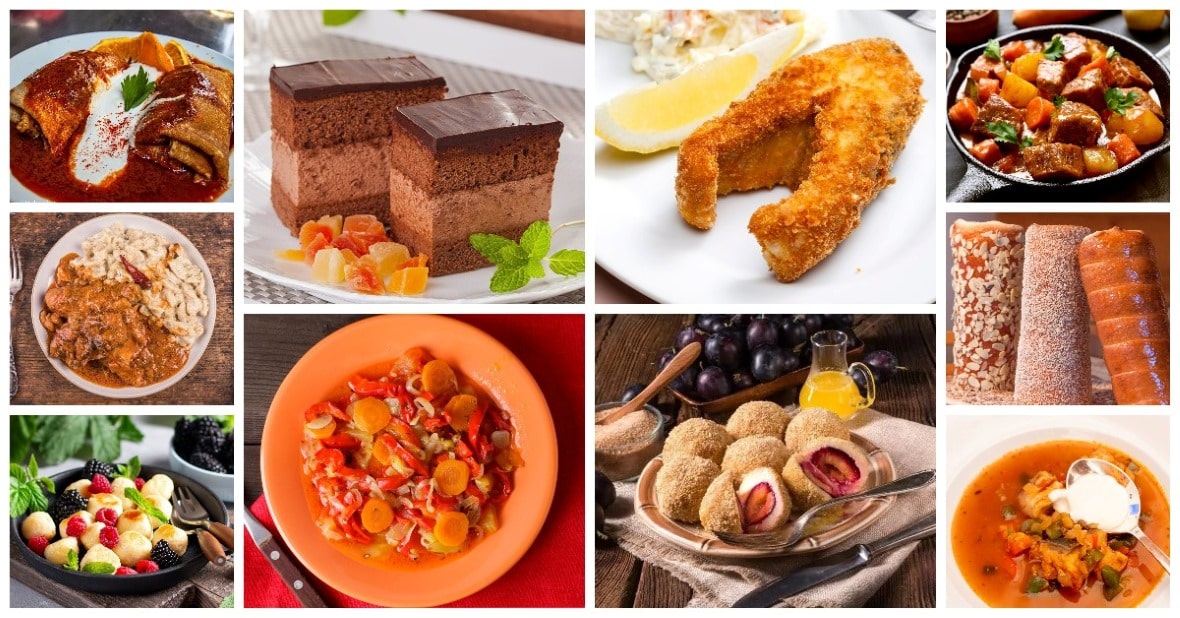
We probably all would like to thank Hungary for giving us paprika and goulash. But how many of us have ventured into the other wonders of Hungarian cuisine?
Before we do, it is worth having a look at what went into making the food of this land-locked central European country as heart warming and moreish as it is.

Like all other cuisines, Hungarian is influenced by its particular history and its geography. Surrounded by Poland, the Czech Republic, Slovakia, Austria, Serbia, and Romania, it’s not surprising that Hungarian cuisine has a lot of foreign influences. People move around, quite naturally, and take their recipes with them.
Many dishes have their roots in neighboring countries or have been influenced by them, and likewise, Hungarian cuisine has greatly influenced its neighbors. Many popular Hungarian foods are served up in Serbia, Romania – especially in Transylvania – and Slovakia.
But that doesn’t mean that Hungarian food doesn’t have its own identity – and this has been shaped by their history. The Magyars, a nomadic people, settled in the Pannonia steppes. Being nomadic, livestock rather than settled agriculture informed the food they ate, and this is reflected in the many traditional meat dishes cooked over an open fire.
The cuisine evolved over the years, of course, and in the 15th century, during the reign of King Mathias and his Neapolitan wife Beatrice, new ingredients were introduced. Sweet chestnuts, garlic, ginger, mace, saffron, nutmeg, and onion found their way into the cuisine, as well as fruit for cooking with meat, in stuffings, and even in pasta making.
Modern history saw the influence of Ottoman and Austrian cuisine, especially food preparation methods, and the cakes and sweets that have a strong German-Austrian influence.
What follows is a round up of some of the most popular Hungarian foods that serves as a starting place only – there is so much more.
1. Gulyás (Goulash)

Goulash, Hungary’s national dish, was first prepared by shepherds who slow cooked diced meat with onions and other flavorings over an open fire until all the liquid was absorbed.
The meat was then dried in the sun, and the shepherds packed it up in their sheep’s stomach bags before they set out with their flock. When it was time to eat, they added water to a portion of meat to reconstitute it into a soup or stew.
The classic “kettle goulash” is prepared by frying diced beef or mutton with onions in lard and adding garlic, caraway seeds, tomatoes, green peppers, and potatoes.
This delicious stew soon became enjoyed at home and over time became the national dish. With potatoes, carrots, onions, celery, peppers, tomatoes and lots of paprika it is nourishing, tasty, and heartwarming. And because it is slow cooked, the usually cheap, tough meat softens into fork-tender chunks.
Another version is székely gulyás, a mouthwatering stew of pork and sauerkraut flavored with tomatoes, onions, caraway seeds, and sour cream. This dish can also be made with chicken.
2. Vadas Marha

Hunter’s stew can be found right across northern Europe, with ingredients varying depending on where you are.
The Hungarian version, vadas marha, can be made with game meat, but it is most often beef that is served up today. The beef is marinated for 2-3 days in vegetables and vinegar, so by the time it is cooked up, with vegetables, bay leaves and juniper berries, and sliced, it is delicious and it is tender.
The slices of meat are served on a bed of “vadas” sauce. This is made with the veggies the meat is cooked in, sour cream, mustard, and a squeeze of lemon, all blitzed until really smooth. The mix of flavors is wonderful, and it is fresh and light and creamy.
But the dish is not complete without the bread roll dumplings traditionally served with it. Cubed and toasted bread rolls are mixed up with eggs, flour, sautéed onions and parsley. The mixture is squished into balls and boiled for a few minutes.
Of course, you can also eat vadas marha with rice or pasta. But for an authentic adventure, make sure they also serve you up the dumplings.
3. Lescó

Tomatoes, peppers and paprika – what could be more Hungarian?
This simple and satisfying ratatouille is ever so easy to make and ever so tasty when made with the ripest of veggies at the end of the summer season.
Bits of bacon or sausage can also be added, and, of course, whatever other veggies you have at hand.
It’s a versatile dish that can be eaten on its own, used as a base for pasta sauces, added to scrambled eggs, or placed on the side of a roast dish. The only limit to its uses are the limits of your imagination.
4. Lángos (Deep-fried Flat Bread)

The popular Hungarian street food lángos is known as the “Hungarian pizza” as it uses the same ingredients for the base as pizza (wheat, yeast, salt, and water). The Turks brought it to the country when they occupied it centuries ago and now this indulgent treat can be found at fairs and local celebrations.
First fried in vegetable oil, the crusty golden flat bread is brushed with minced garlic, topped with sour cream and shredded cheese, which melts deliciously on the hot surface. “Láng” in Hungarian means flame and is so called because, on bread baking days, it was traditionally baked at the front of brick ovens close to the flames.
But because nowadays people don’t have brick ovens, and nor do they do much bread baking at home, lángos is typically deep-fried in oil and sold as a hearty fast-food.
5. Töltött Paprika (Stuffed Peppers)

Another delicious example of Ottoman culinary influence is stuffed peppers, which make a great appetizer or side dish.
Made with Hungarian wax peppers, preferred for their thinner skin and aroma, the inclusion of paprika and tomato sauce and garnish of sour cream give the dish a strong Hungarian character.
The stuffing is a mix of ground beef and pork, rice, chopped onions, minced garlic, parsley, paprika, beaten eggs, salt and pepper.
Töltött paprika are cooked standing up in the oven and topped with tomato sauce sweetened with a pinch of sugar. They are served piping hot with a dollup of sour cream on top.
6. Csirke Paprikás (Chicken Paprikash)

This staple food derives his name from the ample use of paprika, of course. Chicken pieces are simmered in a sauce made with a paprika-infused roux made with equal parts flour and fat (duck or goose fat is good but any kind of fat will do). It is then colored and flavored with paprika.
The chicken is prepared with onions, sweet peppers, and garlic and cooked in the paprika sauce, and once cooked is beautifully tender.
Csirkepaprikás is typically served sour cream and dumpling-like boiled egg noodles (nokedli). Other popular dishes include millet, rice, or tagliatelle. My grandmother always paired it with polenta, and that was just perfect.
7. Gyümölcsleves (Fruit Soup)

This refreshing fruit soup is a summer treat that was enthusiastically adopted by the Austrians, Poles, Slovaks, and Germans. Being a soup, it is not always eaten as a dessert. It works very well too served hot as a starter or main.
There are many variations depending on the fruits in season, which are cooked with cream or whole milk, cloves, cinnamon, and sugar. To turn it into a dessert or appetizer, a small amount of sweet white or red wine along with crème fraîche is added before serving. Other European palates prefer to enjoy it straight from the refrigerator for refreshment on hot summer days.
Gyümölcsleves can be made from red currants, blackberries, apple, pear, or quince, but the most popular fruit soup recipe is meggyleves (sour cherry soup). This dish can be prepared even in the winter using oranges, clementines, or any sweet fruit available – fresh is best but frozen can be used.
8. Húsleves

A rather more typical type of soup, though with its own Hungarian twist, is Húsleves, a beef consommé.
The beef is cooked for a long time, making it oh so tender, and root veggies and noodles are added. It ends up a fragrant, steaming broth, which is a staple for Sunday lunch and for more special occasions such as weddings.
It is often served from a toureen, giving it the status it deserves.
9. Halászlé (Fisherman’s Soup)

One of the hottest dishes native to the European continent is halászlé, a bright red spicy paprika-based fish soup that has a special place on the Hungarian Christmas menu.
Traditionally cooked over an open fire in a bogrács (cauldron), fisherman’s soup is prepared differently whether you are on the banks the Danube or the Tisza. The recipes are much the same though the ratio of ingredients and timing determines its taste.
The depth of flavor comes from the bouillon used, made from fresh fish trimmings including carp heads, bones, skin, and fins that are boiled for two hours in water with red onions, tomatoes, and green peppers.
The base soup is strained and heated for an additional 10 minutes with hot paprika, thick carp filets and roe being added before serving.
10. Főzelék (Vegetable Stew)

You can look at this as a thin vegetable stew or a thick vegetable soup! It’s made with any combination fo potatoes, spinach, kidney beans, bell peppers, cabbage, squash, lentils, peas, tomatoes.
So far, it is a vegetarian dish. But it is often topped with meatballs, spicy sausage, bacon, or hard-boiled eggs for additional flavor. The flavor is also bolstered by the addition of dill, paprika, onions, black peppercorn, garlic, parsley, caraway seeds, and lemon juice or vinegar.
This is a homemade dish, rather than one you’ll find in restaurants, which only rarely include it on the menu. The word főzelék kind of means “something created by cooking” and the main ingredient is put in front to name the dish, so for example zöldborsó főzelék that means “made of green peas”.
11. Somlói Galuska (Hungarian Spongecake)
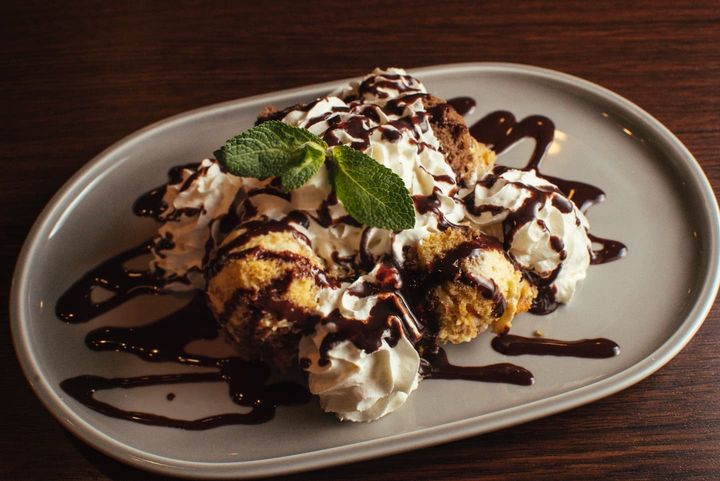
This opulent dessert is a Hungarian favorite and can be found everywhere from gas stations and snack bars to restaurants, so it wont be hard to find when you visit the country. Despite the name, galuska has nothing to do with dumplings apart from being round.
Somlói galuska is a trifle-like cake made with layers of sponge (chocolate, vanilla, and walnut) alternating with creamy custard and rum soaked raisins. and despite being a cake, it is scooped onto a plate, then drizzled with vanilla and orange syrup and chocolate sauce, topped with whipped cream, and sprinkled with roasted ground walnuts.
This 1958 Brussels World’s Fair award-winning cake was invented by the headwaiter of a Budapest restaurant who dreamt it up and the master pastry chef József Béla Szőcs who actually baked it. Over time it has been recreated in many ways and is usually served in small bowls.
12. Pörkölt (Boneless Meat Stew)

Another national dish, pörkölt, is not to be confused with goulash, which has more gravy and bones to the meat.
This stew is more like a ragù and the basic recipe calls for boneless meat, sweet paprika, onions, yellow Hungarian wax peppers, tomatoes (or tomato paste), garlic, green pepper, and marjoram.
Hungarian yellow wax peppers are a key ingredient as red bell peppers are considered too sweet while the green ones are too bitter.
There are some regional variations on the dish, usually using beef or pork, but also lamb, chicken, tripe, or liver. One famous variation, pacalpörkölt, is made with tripe and is quite often spicy. Other takes include: kakaspörkölt, made with rooster; kakashere pörkölt, made with rooster testicles; sertésmáj pörkölt with pork; and csirkemáj pörkölt, using chicken livers. If you are wondering what pörkölt means, well it’s simply “roast”.
13. Dobos Torte (Multi-Layered Sponge Cake)

The ultimate Hungarian cake, as some call it, was created by the supreme master confectioner of the 19th century Austro-Hungarian monarchy – József Dobos. Coming from a long line of confectioners, he innovated by combining unique Hungarian flavors with delicacies of French cuisine. He created the Dobos Cake, the pinnacle of his life-time work for the 1885 National Exhibition.
One legend says that Emperor Franz Joseph and his wife Queen Elizabeth were the first to try it. But another legend says the soul of the cake – the butter cream, was created by accident. An apprentice poured powdered loaf-sugar on to some salted butte.
As butter was preserved in those times, rather than throw it away, József Dobo added cocoa, coffee, and fruit. His search for a dessert that would last longer than the whipped cream desserts of the day and remain edible for several days seemed to be over.
The recipe for this multi layered sponge cake, with chocolate buttercream filling and topped with a thin layer of crunchy caramel, was a secret for a long time and the Dobos Cakes sold in many confectioneries are not made with the original recipe.
14. Töltött Káposzta (Stuffed Cabbage Leaves)
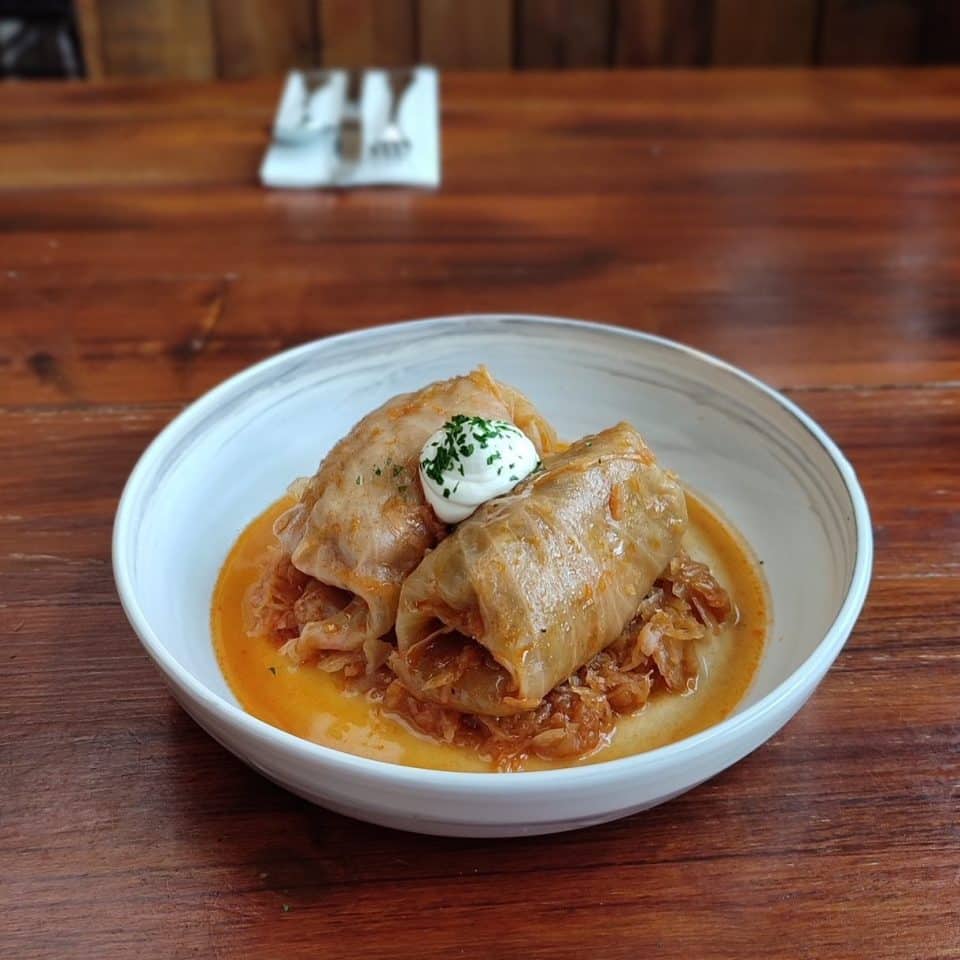
The long evolution of Hungarian cuisine is typified by töltött káposzta, which has its origins in the Ottoman-Turkish cooking method of stuffing leaves. The Hungarian addition was paprika and rice.
Hungary’s first opera diva Róza Széppataki was a big fan of this iconic food and proclaimed it “the coat of arms of Hungary”, back in the 19th century.
Minced light pork meat mixed with onions, spices, and rice is rolled up in fermented cabbage leaves, fresh cabbage leaves, or vine leaves, depending on the region. The veggies added to the stuffing vary too in other countries.
Traditionally töltött káposzta is slowly cooked in the oven or on the stove top with tomato sauce and smoked bacon is added to the pot for additional flavoring. They are served with sour cream and bread, and are cooked for celebrations such as Christmas and at weddings.
Editor’s Note: Stuffed cabbage or vine leaves is a popular dish throughout Eastern and Central Europe.
15. Kürtőskalács ( Sweet Bread)
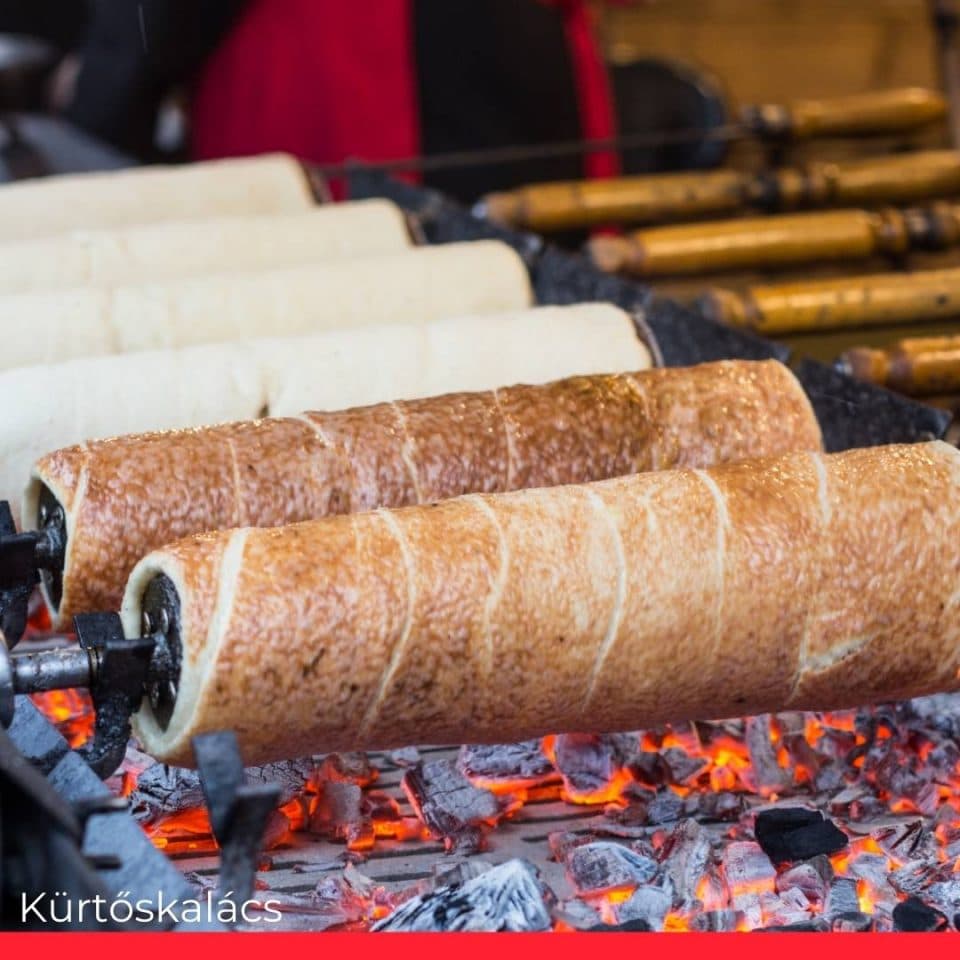
Another Hungarian street food staple is the kürtőskalács, a typical sweet bread specialty popular in all Hungarian speaking regions (for ex. Transylvania).
The cake is cooked on an open fire, which might explain its name, “kürtő“, which translates as “chimney”. “Kalács” means “cake”, thus we can call it “chimney cake.” A strip of sweet dough is spun and wrapped around a cone-shaped baking spit and left to roast over charcoal until the surface is brownish-red in color.
Granulated sugar sprinkled over it forms a shiny crispy crust during caramelization, enhancing the red color of the surface. The cake can be topped with additional ingredients such as cinnamon powder, chopped walnuts, almonds, or coconut flakes. Kids and parents alike love this sweet bread because it makes a great snack. .
The legend has it that a Szeklers’ village was attacked by Tatars and the villagers flew and hid in a cavern of Les Mountain, where they were later discovered. The Tatars were planning to starve them to death but the Szekler leader’s wife had the idea of making a giant flue-shaped milk-loaf to show the Tartars they still had enough food to endure the siege.
16. Túrós Csusza (Cheese Pasta)

Túrós Csusza is the Hungarian take on American “mac and cheese”, However, it’s made mainly from cottage cheese (not cheddar). What makes this dish unique is the combination of hot and cold layers.
The hot bottom layer of cooked pasta and cottage cheese are covered with an extra portion of cold cottage cheese. And now the best part kicks in: hot and juicy bacon gets in the mix before being finished with cold sour cream.
This luscious mixture can be heated in the oven for a few minutes before serving. Traditionally the dish is made with home-made egg pasta. The floury dough is torn by hand into flat small pieces that are then boiled in water. Overall, a perfect comfort food and you’ll be glad to know that the leftovers taste even better.
The name of this restaurant staple and budget-friendly homemade meal refers to the fact that the pasta is slippery due to the sour cream.
17. Szilvásgombóc (Sweet Plum Dumplings)

Hungary is a major plum producer, so dumplings filled with plums are no surprise. Very popular in many Central and East European countries, this dessert is a family favorite and recipes are passed down from grandmother to daughters or nieces.
Mashed potatoes, flour, salt, butter, and optional eggs form the dough that is flattened with a rolling pin to prepare the bed for the dark, juicy plums that are stoned and placed on cut out round shapes of dough.
The dough is then wrapped around the plums and boiled in water. For a finishing touch Szilvásgombóc are rolled over a streusel made of sugar, cinnamon, and fried golden bread crumbs.
Another variation that my grandma used is to fry them in a pan before rolling them through sugar. I can’t say which way I like best, but you can make them at home and tell us.
18. Túrógombóc (Sweet Cottage Cheese Dumplings)

Dumplings are a bit of a theme in Hungarian cuisine and these are paired with the Hungarian penchant for using cheese in sweet dishes, making a wonderful, moist, fluffy ball of dumpling.
Whether you try them for dessert or nip into a coffee shop and have them as a snack, it is essential that you do not leave the country until you have tasted them.
Túró, a sweet cheese much like cottage cheese, is mixed up with butter, sugar, eggs and vanilla, shaped into balls and boiled for around 5 minutes.
They are finished off by rolling them in toasted breadcrumbs and served up with apricot jam. Fluffy clouds of joy!
18. Rakott Krumpli (Potato Casserole)

This is a Jewish take on a Hungarian peasant classic where potatoes, hard boiled eggs, sour cream, and csabai or kielbasa (both are smoked Hungarian sausages) come together in separate layers to form a casserole bursting with flavors. It’s the ultimate comfort food.
This meatless version traditionally calls for trappista, a semi-hard cheese that was brought to Hungary by French monks in the 18th century.
Rakott Krumpli is served on its own for dinner or as a second course after a light soup. As the casserole that leaves out the sausages, it is a traditional meal for Hungarian Jews eaten during the “nine days” when orthodox Jews refrain from eating meat in remembrance of the destruction of the Temple. The literal translation of rakott krumpli is “layered potatoes”, simple and hearty and pairs well with pickled salads.
Have we included all your favorite Hungarian dishes? Let us know in the comments below and share your suggestions with our community!
19. Rántott Ponty Majonézes Krumplisalátával – Fried Carp and Potato Salad with Tartar Sauce

Carp may seem a very surprising choice for many, as it’s rarely eaten in countries like Italy or the United States. But in Central and Eastern Europe, carp fishing and farming have a long tradition and it’s the Christmas food of choice in many households.
Carp is a Christmas favorite in Hungary with the tradition of eating carp for Christmas being adopted from the Czech Republic.
Carp is a somewhat of a challenge, as it’s full of bones. Whether fried or roasted, it’s usually served with delicious vinegar-and-onion-flavored potato salad. We recommend you give it a try!
20. Gundel Palacsinta (Gundel Crepe/Pancake)

Hungarians love pancakes, which here are more like paper-thin crepes. In Hungary, pancakes can be prepared sweet or savory, stuffed with meat.
Sometimes it can be served as a main course after a rich goulash soup but mainly pancakes are a popular dessert in Hungarian households. But there is one which acquired fame beyond the frontier: the Gundel crepe or Gundel pancake.
The quarter folded crepes are filled with rum-walnut filling, fried in butter and served hot with warm chocolate sauce on top.
21. Hortobágyi Palacsinta

So much do hunagarians love their pancakes, there are savory versions too, like these ground chicken wrapped pancakes.
These palacsinta, or pancakes, have a little yogurt added to the mix, and are fried until just golden brown, not a deep brown.
The filling of onion, ground chicken, or veal, sweet paprika, smoked paprika, carraway seeds and tomatoes, is drained in a colander to take out as much of the juice as possible. Doing this prevents the filling from making its way through the pancakes and creating a soggy, mushy mess.
But those juices don’t go to waste. They are mixed with sour cream and poured over the stuffing wrapped pancakes once they are placed in a dish.
The baking simply warms everything through again, as it’s already all cooked. And once the come out, serve them up with an extra dollop of sour cream and a sprig of parsley.
22. Esterházy Torta (Eszterházy Cake)

This is another delicious Hungarian cake that you must try out when you visit Hungary.
The recipe can vary depending on what kind of nuts are available. The thin sponge cake is mostly made with ground walnuts but these can be replaced with almonds or hazelnuts. The cake is filled with hazelnut buttercream made with egg yolks.
It is traditionally topped with glace icing and a chocolate cobweb pattern. Delicious, light and tasty, this is Esterhazy cake!
23. Rigó Jancsi (Gypsy John Cake)

Rigó Jancsi (1858–1927) was a famous Romany Gypsy violinist from Hungary. Why does he have a cake named after him?
Well, he fell in love with a married woman. The two ran off together and their scandalous affair inspired a baker in Budapest to name a cake after him.
It is two layers of luscious chocolate sponge filled with a scandalously rich cream filling and topped with a slab of chocolate and butter.
As scandalously naughty as the story behind it!
24. Pálinka

For a complete feel for Hungarian culture, or any culture really, taste the local hooch. Pálinka is a fruit brandy that is most often found made from plums, apricots, apples, pears, or cherries.
It is served as a shot and, other than Hungarian sweet wine, it is probably the most well-known traditional Hungarian drink.
25. Hungarian Sweet Wine

The sweet wines of Hungary are synonymous with the famous vineyard Tokaji-Hegyalija or, in short, Tokay.
This famous 400-year-old vineyard is recognized by many connoisseurs and has been compared with the wines of Sauternes, Constantia, and with the Trockenbeerenauslese style.
The wine is delicious and a must-try when visiting Hungary.
Hungarian Food Specialties

Some dishes come with a customary side dish. For example, csirkepaprikás (paprika chicken) is always eaten with nokedli (noodles). For some mains, bread is almost mandatory while others are served with rice or potatoes.

A wide range of smoked pork products are staples in Hungarian households. Smoked sausages, smoked ham, and even the lard from smoked sausage can be found on many a cold platter. Together with some good Hungarian bread and fresh veggies, they can be served at home for breakfast or dinner. In restaurants, they are sometimes offered as starters.
Lard is one of the main ingredients in the Hungarian kitchen. Quite often, though, it is substituted with goose-fat, duck-fat, or vegetable oil.

Winter salami is a Hungarian sausage made from Mangalitsa pork and spices and is produced according to a centuries-old tradition. Cured in cold air and slowly smoked, it develops a noble mold on the surface during the ripening process, which enhances the flavor.
The main pickled product is savanyú káposzta (sauerkraut). This was traditionally consumed in winter as a rich source of vitamin C. In summer, an interesting dish of cold hideg meggyleves (sour cherry soup) is served, that cools you in the intense summer heat.
Related: Popular Hungarian Desserts

Related: Most Popular Hungarian Cheeses
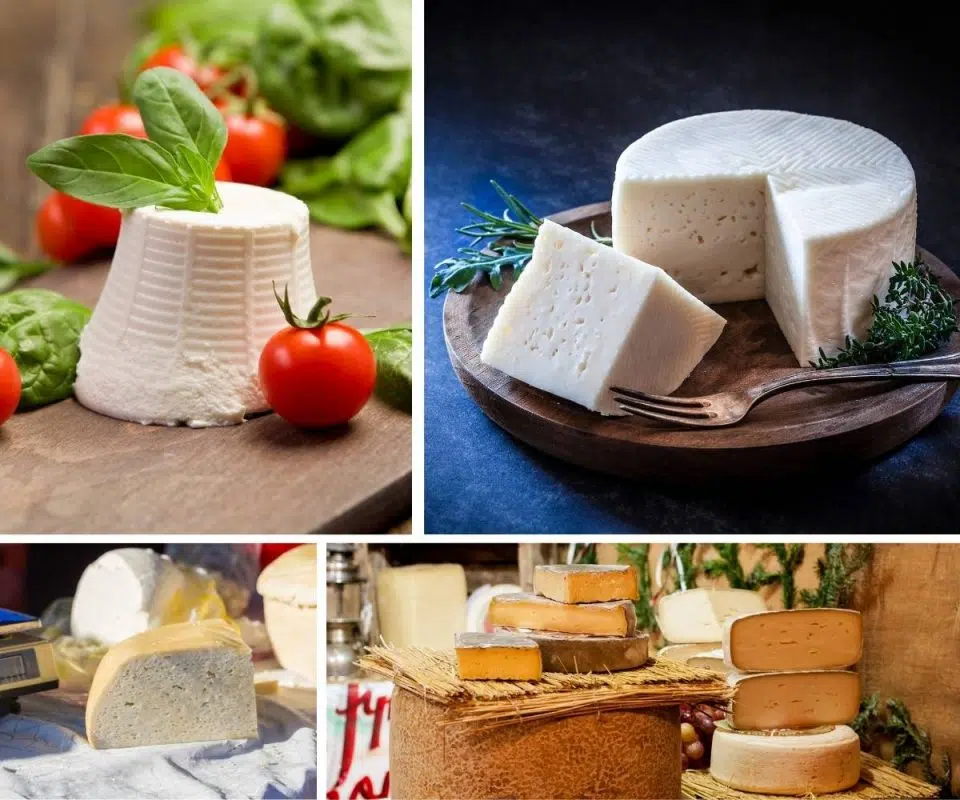
Related: Popular Hungarian Cookies

Check out our list of most popular foods in neighboring countries:
- Most popular Romanian foods
- Most popular Serbian foods
- Most popular Ukrainian foods
- Most Popular Hungarian Desserts

